
In this activity, we will discover how to realize holograms starting from the simulations of a few astrophysical objects, used by researchers in order to analyze physical, chemical, and morphological properties of the phenomenon they want to study.
In order to do that, we will need a tool to record the display of our computer – we have used QuickTime, but you can use many other software, such as for example OBS – and Adobe Premiere Pro, a video-editing program.
In order to start, we should select one of the 3D models published on Sketchfab and record the movement of the object, which we will simulate with the mouse, until we are satisfied with the shooting. We will start by choosing this 3D model, which describes the interaction between a gaseous planet and its parent star:
We will obtain a shooting like this one and we are ready to upload our video to Premiere.
Once inside the editor, we will upload the video we obtained by recording the screen and this image, which will help us set the center and content of our holographic video. On the timeline of Premiere, we will thus have the image which will be the basis (pink strip) and the video of the model (blue stripe).

Attention to this next step: with the mouse, we must take the circle marking the center of the shooting and move it to the center of the square of the basic image; from the keyboard, click on enter. This will define the center of all our holographic videos.
We must fill in all the other spaces of the basic image, therefore we will duplicate the 3D-model video and overlay the copy to the first video. In order to place it correctly, from the window “effects control” we will select “rotation” and write manually 90 (which indicates the degree of rotation). From the keyboard we click on enter and will notice that the duplicate video will have moved, thus filling the triangle on the right of the basic image.

The basic image will not serve us for all the holographic video but only at the beginning to facilitate the placement of the holographic pyramid or the instrument that we will use to activate the hologram, so we leave it for about 3 seconds and then we cut and delete.

With the same method, we have realized two other holographic videos:
The formation of a baby star
The explosion of a nova
Now try and realize many holographic videos!
–
In order to achieve a more fascinating effect, we suggest that you use holographic videos with a tablet. In this way, the holograms will appear larger and the interaction will be more spectacular.
